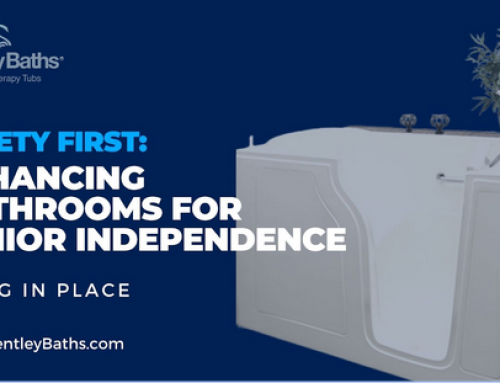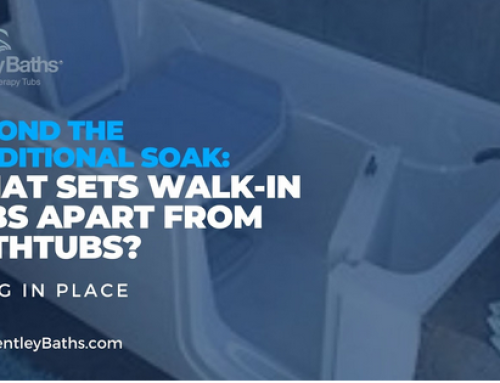My mother broke her hip after falling in the bathtub and passed away in a nursing facility. The event was catastrophic on both an emotional and financial level. All of this could have been avoided, and she could still be alive, with a good walk-in bathtub.
What exactly is a walk-in bathtub? A walk-in bathtub is a type of bathtub with a door built into the side, allowing people to enter the tub directly without having to step over the side. People with mobility problems or other disabilities frequently use these types of bathtubs because they make it simpler for them to enter and exit the tub. For increased safety and support, they generally contain built-in seats and grab bars.
What are the benefits of a walk-in bathtub?
- Increased safety for individuals with mobility impairments or disabilities, as they can easily enter and exit the tub without having to step over a high threshold or climb into the tub.
- Improved accessibility for those who have difficulty stepping over a traditional bathtub threshold or entering a standard tub or shower.
- Some walk-in tubs include built-in safety features, such as grab bars, non-slip surfaces, and built-in seats, to help prevent falls and injuries.
- Some walk-in tubs also offer therapeutic features such as air jets, water jets, and heated surfaces, which can be beneficial for those with chronic pain, arthritis, or other conditions that affect mobility.
- Some walk-in tubs also offer hydrotherapy, which can be beneficial for individuals with conditions such as arthritis, fibromyalgia, and other chronic pain conditions.
Who are walk-in bathtubs made for?
People with walking difficulties, such as those who have restricted movement or have trouble entering and exiting a conventional bathtub, are the target market for walk-in bathtubs. As a result, they can be used by individuals of any age who experience these problems; nevertheless, it’s crucial to speak with a healthcare provider or physical therapist before utilizing one to ensure it is suitable for your particular requirements.
What are the several types of walk-in bathtubs?
Standard walk-in bathtubs: These are the most common type of walk-in bathtub and are designed for individuals who have difficulty stepping over a traditional bathtub wall.
Low-threshold walk-in bathtubs: These have a lower step-in height and are designed for individuals who have difficulty stepping over a standard walk-in bathtub.
Walk-in shower bathtubs: These have a door that allows the user to step directly into the shower area and are designed for individuals who have difficulty stepping over the bathtub wall.
Wheelchair-accessible walk-in bathtubs: These have a wider door and a lower step-in height and are designed for individuals who use a wheelchair.
Air jet walk-in bathtubs: These have air jets that provide a massage while the user is soaking in the tub.
Whirlpool walk-in bathtubs: These have water jets that provide a massage while the user is soaking in the tub.
What is the difference between a regular bathtub and a walk-in bathtub? A normal bathtub that is situated in a bathroom and often features a built-in or detachable shower head is known as a regular bathtub. Stepping over the tub’s edge will get you there. On the other side, a walk-in bathtub has a door or a step that enables the user to enter the tub without having to step over the edge. Walk-in bathtubs are made with safety features like grab bars and non-slip surfaces for those who have limited mobility or other limitations. The water depth of a walk-in bathtub can range from 40 to 48 inches. With seats 17 inches above, there are over 20 inches of depth available for swimming. This depth is advantageous because many walk-in bathtub models come with heated seating options and therapeutic jets.
What to consider when purchasing a bathtub?
Size: Make sure to measure the space where the bathtub will be installed to ensure that it will fit.
Features: Consider what features you want, such as a built-in seat, a grab bar, or a non-slip surface.
Safety: Look for a bathtub with a low threshold or step-in to make it easier to enter and exit the tub, and consider one with a built-in seat for added safety.
Material: Walk-in bathtubs can be made from acrylic or fiberglass, or can be custom-made from cast iron, steel, or porcelain.
Drain and Overflow: Make sure to choose a bathtub that has an easy-to-use drain and overflow, and that complies with the local building codes.
Price: Walk-in bathtubs can vary greatly in price, so make sure to set a budget and compare prices before making a purchase.
Warranty: Be sure to check the warranty offered by the manufacturer and make sure it covers any potential defects in the product.
How much does it cost to install a walk-in bathtub?
Although walk-in baths have many wonderful characteristics, they are rather expensive. Most are usually pretty enormous, thus your installation expenses will most likely be rather significant.
Furthermore, the cost of many of these bathtubs is already quite costly, ranging from $1,000 to $5,000 without installation. If you’re not careful, the cost of installing a bathtub alone can easily reach $10,000, depending on its size and complexity.
How long will a walk-in bathtub last?
A walk-in bathtub should last between 10-15 years with adequate care, depending on the material chosen. Acrylic will have a much longer shelf life than fiberglass, which will typically only last 15 years at most.
Acrylic will usually last between 25 and 30 years. Since walk-in bathtubs are more expensive than ordinary bathtubs, you should be aware of the possibility of buildup and erosion on regions that are not immediately visible to you because you may not use the entire surface area while bathing.









